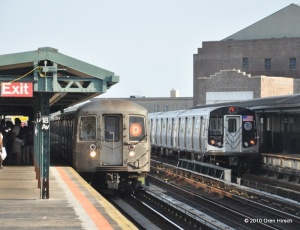 R62A 1946
R62A 1946
Location: Grand Central, New York, NY
Operator of Vehicle: MTA New York City Transit
Date of Photo: June 20, 2009
On this date in 1913, Grand Central Terminal opened following ten years of construction. Today’s Grand Central is not the first train station to be built on that site. The first Grand Central Depot opened in October of 1871 with 12 tracks. At that time, it was the largest open space in the United States and the largest railroad station in the world. However, the station reached capacity by the mid-1890s. An annex was added but capacity was reached again in 1897. The terminal was reconstructed and in 1900, became known as Grand Central Station.
At that time, the trains serving the station were steam hauled, which meant that the busy tunnel under Park Avenue leading to the station from the north (the only way for trains to access the station) was filled with smoke and soot. Following a January 1902 crash that killed 15 passengers, the New York Central Railroad (which owned Grand Central) and the New York State legislature agreed to only operate electric trains into the terminal. Less than 12 months after that fatal collision, New York Central Vice President William J. Wilgus proposed an extension of the Park Avenue Tunnel by covering the existing open cut used by the railroad from 46th Street to 59th Street. This was now feasible because once Grand Central was only served by electric trains, there would be no need to vent smoke and soot from steam trains (since there wouldn’t be any). The air rights over the terminal could then be sold to raise money for the railroad. This proposal had to be approved and enacted upon quickly because plans were already underway for the Interborough Rapid Transit Company (better known as the IRT and now a part of the New York City Subway) to build subway lines around Grand Central, at which time the New York Central would lose its rights to construct underground in that area. The new station was built in phases around the existing station so as to maintain train service throughout the duration of the project. The rebuilt terminal, now known as Grand Central, saw its first train arrive just minutes after midnight on February 2, 1913.
In the ensuing 110 years, Grand Central has served as a catalyst for development in what is now Midtown Manhattan. At the time Cornelius Vanderbilt commissioned the original Grand Central, there was not much in the way of development in the area. However, he was convinced New York City would grow to the north and eventually, his railroad terminal would be in the heart of the city. His vision proved to be very accurate, to the point that the Long Island Railroad began a long term project (that was first proposed in the 1960s) to connect its tracks to Grand Central Terminal in the 1990s when surveys indicated most LIRR riders worked near Grand Central, not Penn Station where LIRR trains terminate. That project, known as East Side Access and more recently as “Grand Central Madison” culminated in the opening of eight new tracks served by four new platforms 140 feet below street level on January 25, 2023.
Prior to the opening of Grand Central Madison, the most recent significant change to Grand Central was on the New York City Subway’s shuttle platforms. As part of the 2015-2019 MTA Capital Program, the 42nd Street Shuttle that connects Grand Central to Times Square became ADA accessible and as part of that project, Track 3, the center shuttle track and the one the train in this photo is using, was removed. The single island platform that now exists between Track 1 and Track 4 measures 22,000 square feet (2,000 square meters) and is the largest platform in the New York City by area. The rebuilt Shuttle reopened on September 7, 2021. You can see where Track 3 was by looking at the floor tiles on the new platform, the pattern of the tiles and columns between the floor and ceiling indicate where the track right-of-way used to be.
For more photos of R62A trains, please click here.

 New Flyer C40LF 259
New Flyer C40LF 259 M9 9010
M9 9010
 R62A 1946
R62A 1946